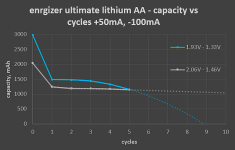belllfador
1 mW
Once upon a time... I was checking my stash of NiMH batteries and everything except eneloops was in very poor shape, specially the 9V rechargeables. I did some tricks to restore them, but self discharge and capacity remained unexceptable. Fast web search and apparently most of the small nimh batteries have a life of around 5 years. Lets include missing manufacturing date, x time in the store... and my multimeters were back in non-rechargeable mafia. I was a bit frustrated. Why my choises need to be so limited, why the market don't offer long lasting rechargeable for the mainstream user?
Thinking about such existential questions leads me to the dark side of forgotten knowing and dangerous experiments. Alkaline batteries have potential to be recharged, wiki link, youtube link. 3V primary lithium has a rechargeable variant with short cycle life, but there is no available data for the 1.5V LiFeS2. You know what is coming next.
RECHARGING PRIMARY LITHIUM BATTERIES IS DANGEROUS! THEY CAN EXPLODE IN FLAMES AND RELEASE TOXIC GASES!
Next tests are done for 3 types AA batteries:
rechargeable alkaline - lightweight, without any date, probably fake,
duracell intense power - industrial grade alkaline with low IR,
energizer ultimate lithium - best of the best with 25 years shelf life.
Safety measures are taken!
For charging alkaline I use pulse current constant voltage 1.65V, 100Hz, pwm 75%, RMS 30 mA or 45mA with 0.5ms 250mA negative (discharging) pulse. For lithium - pulse charging 25mHz, pwm 67%, RMS 50mA with 0.7A 5ms negative, voltage limit 2.06 or 1.93V. All values are away from optimal, the study is just a starting point.





No leiking, exploding or noticeable self discharge is observed. But probably will check after 1 and 6 months.
Is good to be known that skyrc MC3000 is using 0.1Hz pwm 70% for recharging alkaline (RAM). There are cheaper chargers, but I don't know what algorithm they used. Charging 1.5V primary lithium is not worth the risk, except when the zombies are scratching on the front door.
Thinking about such existential questions leads me to the dark side of forgotten knowing and dangerous experiments. Alkaline batteries have potential to be recharged, wiki link, youtube link. 3V primary lithium has a rechargeable variant with short cycle life, but there is no available data for the 1.5V LiFeS2. You know what is coming next.
RECHARGING PRIMARY LITHIUM BATTERIES IS DANGEROUS! THEY CAN EXPLODE IN FLAMES AND RELEASE TOXIC GASES!
Next tests are done for 3 types AA batteries:
rechargeable alkaline - lightweight, without any date, probably fake,
duracell intense power - industrial grade alkaline with low IR,
energizer ultimate lithium - best of the best with 25 years shelf life.
Safety measures are taken!
For charging alkaline I use pulse current constant voltage 1.65V, 100Hz, pwm 75%, RMS 30 mA or 45mA with 0.5ms 250mA negative (discharging) pulse. For lithium - pulse charging 25mHz, pwm 67%, RMS 50mA with 0.7A 5ms negative, voltage limit 2.06 or 1.93V. All values are away from optimal, the study is just a starting point.





No leiking, exploding or noticeable self discharge is observed. But probably will check after 1 and 6 months.
Is good to be known that skyrc MC3000 is using 0.1Hz pwm 70% for recharging alkaline (RAM). There are cheaper chargers, but I don't know what algorithm they used. Charging 1.5V primary lithium is not worth the risk, except when the zombies are scratching on the front door.

